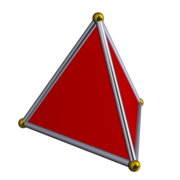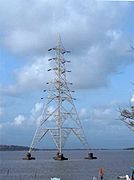3.5 Town's lattice trusstruss
Characteristics of trusses
A truss consists of typically (but not necessarily) straight members connected at joints, traditionally termed panel points. Trusses are typically (but not necessarilycomposed of triangles because of the structural stability of that shape and design. A triangle is the simplest geometric figure that will not change shape when the lengths of the sides are fixed. In comparison, both the angles and the lengths of a four-sided figure must be fixed for it to retain its shape. The joint at which a truss is designed to be supported is commonly referred to as the Munter Point.
Planar truss

The roof trusses of the basilica di Santa Croce (Florence)
The simplest form of a truss is one single triangle. This type of truss is seen in a framedroof consisting of rafters and a ceiling joist, and in other mechanical structures such as bicycles and aircraft. Because of the stability of this shape and the methods of analysis used to calculate the forces within it, a truss composed entirely of triangles is known as a simple truss. However, a simple truss is often defined more restrictively by demanding that it can be constructed through successive addition of pairs of members, each connected to two existing joints and to each other to form a new joint, and this definition does not require a simple truss to comprise only triangles. The traditional diamond-shape bicycle frame, which utilizes two conjoined triangles, is an example of a simple truss.
Space frame truss
A space frame truss is a three-dimensional framework of members pinned at their ends. A tetrahedron shape is the simplest space truss, consisting of six members which meet at four joints.Large planar structures may be composed from tetrahedrons with common edges and they are also employed in the base structures of large free-standing power line pylons
|
|
Diagram of a planar space frame such as used for a roof
|
|
|
A pylon, a three-dimensionally trussed structure
|
|
Truss types

A large timber Howe truss in a commercial building
- For more truss types, see List of truss types or Truss Bridge.
There are two basic types of truss:
- The pitched truss, or common truss, is characterized by its triangular shape. It is most often used for roof construction. Some common trusses are named according to their web configuration. The chord size and web configuration are determined by span, load and spacing.
- The parallel chord truss, or flat truss, gets its name from its parallel top and bottom chords. It is often used for floor construction.
Pratt truss

The
Pratt truss was patented in 1844 by two Boston railway engineers, Caleb Pratt and his son Thomas Willis Pratt.The design uses vertical members for compression and horizontal members to respond to tension. What is remarkable about this style is that it remained popular even as wood gave way to iron, and even still as iron gave way to steel.The continued popularity of the Pratt truss is probably due to the fact that the configuration of the members means that longer diagonal members are only in tension for gravity load effects.
Bowstring truss
Named for their shape, bowstring trusses were first used for arched truss bridges, often confused with tied-arch bridges.
Thousands of bowstring trusses were used during World War II for holding up the curved roofs of aircraft hangars and other military buildings. Many variations exist in the arrangements of the members connecting the nodes of the upper arc with those of the lower, straight sequence of members, from nearly isosceles triangles to a variant of the Pratt truss.
King post truss
One of the simplest truss styles to implement, the king post consists of two angled supports leaning into a common vertical support.
The queen post truss, sometimes queenpost or queenspost, is similar to a king post truss in that the outer supports are angled towards the center of the structure. The primary difference is the horizontal extension at the centre which relies on beam action to provide mechanical stability. This truss style is only suitable for relatively short spans.

 The Pratt truss was patented in 1844 by two Boston railway engineers, Caleb Pratt and his son Thomas Willis Pratt.The design uses vertical members for compression and horizontal members to respond to tension. What is remarkable about this style is that it remained popular even as wood gave way to iron, and even still as iron gave way to steel.The continued popularity of the Pratt truss is probably due to the fact that the configuration of the members means that longer diagonal members are only in tension for gravity load effects.
The Pratt truss was patented in 1844 by two Boston railway engineers, Caleb Pratt and his son Thomas Willis Pratt.The design uses vertical members for compression and horizontal members to respond to tension. What is remarkable about this style is that it remained popular even as wood gave way to iron, and even still as iron gave way to steel.The continued popularity of the Pratt truss is probably due to the fact that the configuration of the members means that longer diagonal members are only in tension for gravity load effects. 




